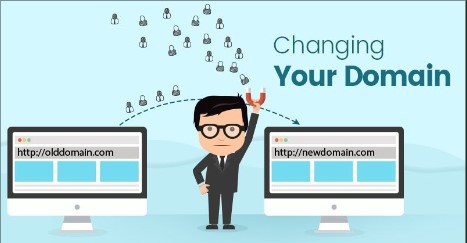Get My Own Email Domain
In the bustling world of digital communication, where emails flood our inboxes by the second, standing out from the crowd is paramount.
One effective way to carve your niche in this landscape is through the utilization of personalized email domains. But what exactly are email domains, and why do they matter? Let’s delve deeper into this digital realm to understand the significance of having your email domain.
Understanding Email Domains
Defining Email Domains: The Backbone of Professional Communication
In the vast and intricate web of digital communication, email domains stand as the linchpin, orchestrating the seamless exchange of messages across the global network.
At its essence, an email domain is akin to the digital address of your virtual abode, guiding messages to their rightful destinations amidst the digital ether. It serves as the identifier, the locator, and the guardian of your online presence, encapsulating the essence of your digital identity within a succinct string of characters.
An email domain comprises two fundamental components: the local part and the domain name. The local part, preceding the “@” symbol, signifies the individual or entity to whom the email is addressed. It often mirrors a user’s name, alias, or organizational designation, serving as a personalized identifier in the vast expanse of cyberspace.
Meanwhile, the domain name, following the “@” symbol, serves as the digital territory under which the email address resides. It functions as the beacon, directing incoming messages to the designated server responsible for their reception and delivery.
Consider, for instance, the email address “contact@yourcompany.com.” Here, “contact” denotes the local part, representing the intended recipient or department, while “yourcompany.com” delineates the domain name, indicating the digital realm under which the email address operates.
Together, these components form the crux of professional communication, providing a structured framework for the exchange of information, ideas, and interactions in the digital domain.
Free vs. Custom Domains: Unveiling the Differences
In the labyrinth of email options, users are often confronted with the choice between free email services and custom domains, each bearing distinct advantages and limitations.
Free email services, such as Gmail, Yahoo, or Outlook, offer convenience and accessibility, catering to the needs of casual users and small-scale endeavors. These platforms provide users with instant access to email functionality, requiring minimal setup and configuration to get started.
However, the allure of “free” comes with a trade-off, as users are often subjected to limitations in terms of branding, customization, and control over their digital identities.
On the contrary, custom email domains empower users with unparalleled autonomy and versatility, enabling them to craft personalized email addresses aligned with their brand identity and organizational ethos.
By leveraging custom domains, businesses can establish a distinct digital presence, imbued with professionalism, credibility, and brand consistency.
Whether it’s “info@yourcompany.com” or “hello@yourbrand.com,” custom email addresses lend an air of legitimacy and authenticity to communications, instilling trust and confidence in recipients.
Moreover, custom email domains afford users greater control over security measures, data privacy, and branding elements, safeguarding sensitive information and preserving the integrity of communications.
With custom domains, businesses can implement robust security protocols, such as encryption, spam filtering, and firewalls, to fortify their digital defenses against cyber threats and phishing attacks.
Additionally, custom domains offer scalability, flexibility, and customization options, allowing businesses to adapt and evolve their email infrastructure to suit evolving needs and exigencies.
In essence, while free email services offer convenience and accessibility, custom domains serve as the cornerstone of professional communication, empowering users with autonomy, credibility, and security in the digital realm.
By embracing the power of custom email domains, businesses can unlock new dimensions of communication, collaboration, and brand stewardship, propelling them toward greater success and distinction in the digital age.
Advantages of Having Your Email Domain
In the bustling arena of digital communication, where first impressions can make or break professional relationships, the significance of having your email domain cannot be overstated.
Beyond mere convenience, custom email domains offer a plethora of advantages that elevate your brand image, fortify security measures, and enhance the efficacy of your communication strategies. Let’s explore the manifold benefits of embracing a personalized email domain:
Establishing Credibility: Elevating Your Brand Image
In the realm of business, credibility is currency. A custom email domain lends an air of professionalism and authenticity to your correspondence, signaling to recipients that you are a bona fide entity worthy of their trust and patronage.
Whether you’re a burgeoning startup or a well-established enterprise, a personalized email domain communicates a commitment to excellence and attention to detail, setting you apart from competitors and instilling confidence in your clientele.
Consider the scenario: would you feel more inclined to engage with a company represented by the email address “yourname@gmail.com” or “yourname@yourcompany.com”? The latter exudes a sense of legitimacy and authority, fostering trust and rapport with recipients from the outset.
By leveraging a custom email domain, you demonstrate a vested interest in cultivating a professional image and nurturing long-term relationships with clients, partners, and stakeholders.
Strengthening Brand Identity: Consistent Messaging Across Platforms
Consistency is the cornerstone of brand identity. A custom email domain allows you to integrate your brand name seamlessly into your digital communications, reinforcing brand recall and resonance with every email sent.
Whether it’s “info@yourbrand.com” or “contact@yourcompany.com,” your email address serves as a virtual ambassador of your brand, imparting a sense of cohesion and credibility across diverse touchpoints.
Moreover, custom email domains enable you to customize email signatures, incorporating branding elements such as logos, taglines, and color schemes to enhance brand visibility and memorability.
With each email interaction, you reinforce your brand identity and cultivate a cohesive brand experience that resonates with recipients, fostering loyalty and affinity over time.
Enhanced Security: Protecting Sensitive Communication
In an era fraught with cyber threats and data breaches, safeguarding sensitive information is paramount. Custom email domains offer advanced security features and robust encryption protocols to shield your communications from prying eyes and malicious actors.
Unlike free email services, which may be susceptible to hacking attempts and privacy breaches, custom domains afford greater control over security measures, enabling you to implement stringent access controls and authentication mechanisms to protect confidential data.
Additionally, custom email domains empower you to enforce domain-based authentication protocols, such as SPF (Sender Policy Framework) and DKIM (DomainKeys Identified Mail), to verify the authenticity of outgoing emails and mitigate the risk of phishing attacks.
By fortifying your digital defenses with a custom email domain, you can safeguard your organization’s reputation, intellectual property, and sensitive information from unauthorized access and exploitation.
Improved Deliverability: Ensuring Emails Reach the Inbox
The fate of your emails hinges on deliverability. Custom email domains enjoy higher deliverability rates compared to free email services, as they are less likely to be flagged as spam or blacklisted by email filters.
By maintaining a reputable domain reputation and adhering to industry best practices, you can maximize the likelihood of your emails reaching recipients’ inboxes, thereby amplifying your reach and engagement with your target audience.
Moreover, custom email domains enable you to monitor and analyze email delivery metrics, such as open rates, click-through rates, and bounce rates, to optimize your communication strategies and maximize the effectiveness of your campaigns.
With greater control over your email infrastructure, you can fine-tune your delivery practices, segment your audience, and personalize your messaging to resonate with recipients on a deeper level, driving meaningful interactions and fostering long-term relationships with clients and stakeholders.
In conclusion, the advantages of having your email domain extend far beyond mere convenience or branding aesthetics. From establishing credibility and fortifying security measures to enhancing deliverability and brand resonance, custom email domains serve as a cornerstone of professional communication, empowering businesses to cultivate trust, foster loyalty, and achieve lasting success in the digital age.
By embracing the power of personalized email domains, you unlock new dimensions of connectivity, authenticity, and influence, propelling your brand toward greater heights of distinction and excellence.
Steps to Get Your Email Domain
Choosing the Perfect Domain Name: Tips and Strategies
Selecting the right domain name is a pivotal decision that warrants careful consideration. Aim for a domain that is concise, memorable, and reflective of your brand identity.
Conduct thorough research to ensure its availability and steer clear of trademark infringements or obscure extensions. Additionally, prioritize readability and avoid hyphens or numbers that may detract from your professionalism.
Selecting a Reliable Domain Registrar: Key Considerations
Your domain registrar plays a pivotal role in managing your online presence, making it imperative to choose a reputable provider. Evaluate factors such as pricing, customer support, and domain management tools to make an informed decision.
Look for registrars accredited by regulatory bodies and equipped with robust security measures to safeguard your domain against potential threats.
Registering Your Domain: A Step-by-Step Guide
Once you’ve zeroed in on the perfect domain name and registrar, the next step is to initiate the registration process. This typically involves verifying domain availability, providing requisite contact information, and completing payment for registration fees. Be sure to review the terms of service and registration duration to avoid any surprises down the line. Upon successful registration, you gain exclusive rights to your domain for the specified timeframe, empowering you to wield it as a powerful branding asset.
Connecting Your Domain to Email Hosting: Making it Functional
With your domain secured, the final piece of the puzzle is to integrate it with an email hosting provider to unleash its full potential. Opt for a reputable hosting service that aligns with your business needs and offers seamless integration with your chosen domain registrar.
Configure DNS settings to point your domain to the designated email servers, enabling you to create personalized email addresses and embark on your journey toward streamlined communication.
Selecting the Right Email Hosting Provider
Evaluating Security Measures: Encryption, Spam Filtering, and Firewalls
When entrusting your email communication to a hosting provider, prioritizing security is paramount. Assess the provider’s encryption protocols, spam filtering capabilities, and firewall protection to safeguard your sensitive data from prying eyes and malicious attacks.
Look for certifications such as SSL/TLS encryption and robust intrusion detection systems to fortify your digital fortress and uphold the confidentiality of your correspondence.
Assessing Storage Options: Scalability and Backup Solutions
Scalability is a critical consideration in the realm of email hosting, especially for growing businesses with evolving needs. Ensure your chosen provider offers ample storage space and flexible upgrade options to accommodate future expansion without compromising performance.
Additionally, inquire about backup solutions and data retention policies to mitigate the risk of data loss and ensure continuity of operations in the event of unforeseen disasters.
User-Friendly Interfaces: Simplifying Email Management
Navigating the complexities of email management shouldn’t feel like a Herculean task. Opt for an email hosting provider that boasts intuitive interfaces and user-friendly features to streamline administrative tasks and enhance productivity.
Look for functionalities such as drag-and-drop email organization, customizable filters, and seamless integration with third-party applications to optimize your workflow and empower your team to collaborate effortlessly.
Customer Support: 24/7 Assistance for Peace of Mind
When entrusting your critical communication infrastructure to a third-party provider, responsive customer support becomes non-negotiable.
Prioritize providers that offer round-the-clock assistance via multiple channels, including live chat, email, and phone support. Evaluate the provider’s reputation for customer service excellence through reviews and testimonials to ensure prompt resolution of any issues or concerns that may arise along the way.
Setting Up and Managing Your Email Domain
Creating and Configuring Email Accounts: Setting Up Your Inbox
With your email domain and hosting infrastructure in place, the next step is to create and configure email accounts tailored to your specific needs. Define user roles and permissions to grant access to relevant team members while safeguarding sensitive information.
Customize email settings such as aliases, signatures, and autoresponders to streamline communication and uphold brand consistency across all outgoing correspondence.
Implementing DNS Records: Ensuring Proper Functionality
DNS (Domain Name System) records serve as the backbone of your email infrastructure, facilitating seamless communication between servers and directing traffic to the appropriate destinations.
Configure MX (Mail Exchange) records to specify the mail server responsible for processing incoming emails and SPF (Sender Policy Framework) records to prevent spoofing and unauthorized email delivery. Regularly audit and update DNS settings to maintain optimal performance and prevent potential disruptions to your email services.
Safeguarding Your Data
Data is the lifeblood of modern businesses, making data protection a top priority for organizations of all sizes. Implementing automated backup solutions is critical to safeguarding your email data against accidental deletion, hardware failures, or cyber-attacks.
Choose a robust backup system that offers frequent, incremental backups and secure storage options to ensure the integrity and accessibility of your critical communication data. Regularly test your backup procedures to verify their effectiveness and address any potential vulnerabilities proactively.
Regular Maintenance: Keeping Your Email System Healthy
Proactive maintenance is essential to the longevity and performance of your email infrastructure. Develop a routine maintenance schedule to monitor system health, diagnose potential issues, and implement necessary updates or patches promptly.
Conduct regular audits of user accounts, permissions, and security configurations to mitigate the risk of unauthorized access or data breaches. Additionally, educate your team on best practices for email management and security to foster a culture of vigilance and accountability within your organization.
Best Practices for Professional Email Communication
Crafting the Perfect Email Signature: Making a Lasting Impression
An email signature serves as a digital business card, encapsulating your identity and contact information in a concise, visually appealing format. Craft a professional email signature that includes your name, title, company name, and relevant contact details, such as phone number and website URL.
Consider incorporating branding elements such as logos or color schemes to reinforce brand identity and leave a lasting impression on recipients.
Mastering Email Etiquette: Dos and Don’ts for Effective Communication
Effective communication hinges on adhering to established email etiquette norms and conventions. Practice brevity and clarity in your email communications, avoiding unnecessary jargon or ambiguity that may lead to misunderstandings.
Use appropriate salutations and tone to convey professionalism and respect, and proofread your messages for spelling and grammar errors before hitting send. Exercise caution when using features such as Reply All or CC to avoid cluttering recipients’ inboxes with irrelevant correspondence.
Training Your Team: Ensuring Consistency Across the Organization
Consistency is key to maintaining a unified brand identity and upholding professional standards of communication.
Provide comprehensive training and guidelines to your team members on email best practices, including proper formatting, tone, and security protocols. Foster a culture of accountability and continuous improvement by soliciting feedback and conducting regular performance reviews to identify areas for refinement and enhancement.
Monitoring Performance: Tracking Metrics for Continuous Improvement
In the dynamic landscape of email communication, data-driven insights are invaluable for optimizing performance and driving strategic decision-making. Leverage email analytics tools to track key metrics such as open rates, click-through rates, and response times to gauge the effectiveness of your email campaigns and identify areas for improvement.
Use A/B testing to experiment with different subject lines, content formats, and calls to action to refine your approach and maximize engagement with your target audience.
Troubleshooting Common Issues with Email Domains
Resolving Delivery Problems: Troubleshooting Tips
Delivery problems can arise due to a variety of factors, including misconfigured DNS settings, blacklisting issues, or spam filtering algorithms. Diagnose delivery issues by reviewing bounce-back messages or tracking delivery logs provided by your email hosting provider.
Address common issues such as invalid recipient addresses, exceeding message size limits, or misconfigured mail servers to restore normal email delivery functionality promptly.
Combatting Spam and Phishing: Protecting Your Inbox
Spam and phishing attacks pose significant threats to the security and integrity of your email communication. Implement robust spam filtering mechanisms and anti-phishing protocols to detect and block suspicious emails before they reach your inbox.
Educate your team on how to recognize phishing attempts and avoid clicking on suspicious links or downloading attachments from unknown senders. Regularly update your spam filtering rules and security protocols to stay ahead of emerging threats and protect your organization’s sensitive information.
Dealing with Technical Glitches: When to Seek Expert Help
Despite meticulous planning and preventive measures, technical glitches may still occur, disrupting your email communication workflow. Know when to seek expert help from your email hosting provider or IT support team to diagnose and resolve complex technical issues beyond your expertise.
Promptly report any service outages, performance degradation, or unusual behavior to expedite resolution and minimize downtime for your organization.
Conclusion: Unlocking the Potential of Your Email Domain
In today’s fast-paced business landscape, effective communication is the cornerstone of success. By harnessing the power of personalized email domains, organizations can elevate their brand image, enhance security, and streamline communication workflows.
From selecting the perfect domain name to implementing robust security measures and mastering email etiquette, the journey toward personalized communication begins with a single step. Embrace the potential of your email domain to future-proof your communication infrastructure and adapt to evolving business needs with confidence and agility.





